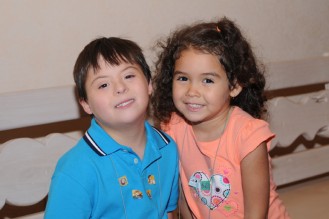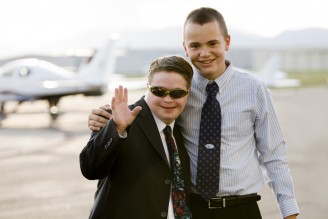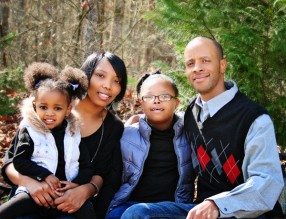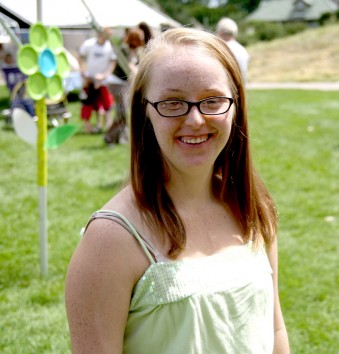Facts and FAQ About Down Syndrome

 In the U.S., Down syndrome is the least funded major genetic condition by our National Institutes of Health despite being the most frequent chromosomal disorder. Because of this, and because of lack of funding from other government organizations, there is surprisingly little known definitively about the condition.
In the U.S., Down syndrome is the least funded major genetic condition by our National Institutes of Health despite being the most frequent chromosomal disorder. Because of this, and because of lack of funding from other government organizations, there is surprisingly little known definitively about the condition.
The Global Down Syndrome Foundation is committed to funding medical and basic research that will provide answers to the many questions that remain.
What is Down syndrome?
What is the cause of Down syndrome?
What is the population of people with Down syndrome?
What should you know about people with Down syndrome in the U.S.?
How do medical issues and care affect people with Down syndrome?
How will a baby with Down syndrome affect my family?
You are pregnant – What if your doctor offers a prenatal test to see if your baby has Down syndrome?
What is the future for a person with Down syndrome in the U.S.?
What are the hurdles?
Facts about Down syndrome: What is Down syndrome?
1. Down syndrome is named after the English doctor, John Langdon Down, who was the first to categorize the common features of people with the condition.
2. Dr. Jerome Lejeune discovered Down syndrome is a genetic disorder whereby a person has three copies of chromosome 21 instead of two.
- There are also very rare forms of Down syndrome (less than 6%) called Translocation Down Syndrome or Mosaic Down Syndrome in which not all of the chromosome is triplicated or not all cells of the body carry the extra chromosome.
3. Down syndrome is the most frequently occurring chromosomal disorder and the leading cause of intellectual and developmental delay in the U.S. and in the world.
 What is the cause of Down syndrome?
What is the cause of Down syndrome?
1. The cause of Down syndrome is unknown.
- In a process called non-disjunction, the two copies of chromosome 21 fail to separate during formation of the egg, resulting in an egg with two copies of the chromosome. When this egg is fertilized, the resulting baby ends up with three copies of chromosome 21 in each of its cells. The cause of this non-disjunction remains unknown.
2. The chance of having a baby with Down syndrome increases with the mother’s age; however, about half of babies born with Down syndrome are born to mothers under 35 years old simply because more young women are having babies.
3. Down syndrome has nothing to do with race, nationality, socioeconomic status, religion, or anything the mother or father did during pregnancy.
4. There is NO correlation between incest and Down syndrome.
5. Between two and four percent of the time, a person is born with Mosaic translocation Down syndrome (mDs) whereby some but not all of the cells have an extra copy of the 21st chromosome and the other cells are not affected. Translocation happens when a piece of chromosome 21 becomes attached to another chromosome during cell division.
In the case of hereditary Translocation Down syndrome (a rare one to two percent of all people with Down syndrome), an extra chromosome 21 is inherited from one of the parents.
What is the population of people with Down syndrome?
1. The Centers for Disease Control (CDC) in 2011 estimated the frequency of Down syndrome in the US is 1 in 700 live births (up from 1 in 1087 in 1990)
2. The estimate that 90% of pregnant women in the U.S. who get a diagnosis of Down syndrome through amniocentesis choose to terminate IS INACCURATE.
- This statistic is based on studies done that merged findings from the U.S., UK and Europe in the mid- to late 1990s. The numbers do not represent the attitudes of the US population then or today.
- A more targeted 2012 review of just United States data and termination rates following a prenatal diagnosis for Down syndrome estimates termination rates from 1995 – 2011 were about 67%.
3. Surprisingly, The population of people in the US with Down syndrome is currently unknown. What we do know is:
- 38% of Americans know someone with Down syndrome.
- Because of the increase of live births of people with Down syndrome and the recent dramatic increase in their lifespan, over the next 20 years a significant increase in the population of people with Down syndrome in the U.S. is expected.
- The population of people with Down syndrome in the U.S. has been estimated to be over 400,000. However, this number is derived from faulty assumptions – the total population from the 2000 US census, 281.4 million people, divided by the most current frequency of live births, 691 equaling 407,236. Unfortunately, this technique takes no account of the gradual increase in frequency or the increase in lifespan of people with Down syndrome. Thus, we don’t actually know how many people with Down syndrome currently live in the U.S.4. Some estimates put the worldwide population of people with Down syndrome at more than 6 million. More research is needed to ascertain whether this number is accurate.
 What should you know about people with Down syndrome in the U.S.?
What should you know about people with Down syndrome in the U.S.?
1. Today the average lifespan of a person with Down syndrome is approximately 60 years.
- As recently as 1983, the average lifespan of a person with Down syndrome was 25 years. The dramatic increase to 60 years is largely due to the end of the inhumane practice of institutionalizing people with Down syndrome.
2. Most children with DS function in the mild to moderate range of cognitive impairment.
3. People with Down syndrome have physical and intellectual delays from birth but there is a wide variety of abilities within the population that are impossible to predict ahead of time.
4. By law, people with Down syndrome in the U.S. must be provided an appropriate and free public education.
5. A growing number of people with Down syndrome live independently.
6. A small but growing number of people with Down syndrome are choosing to get married and live together.
How do medical issues and care affect people with Down syndrome?
1. People with Down syndrome are significantly predisposed to certain medical conditions including congenital heart defects, sleep apnea, and Alzheimer’s disease. There is also evidence of an increased risk of celiac disease, autism, childhood leukemia and seizures.
- Some research shows that people with Down syndrome who have certain heart defects or childhood leukemia are more likely than their typical counterparts to recover or recover quickly.
- More research is needed to assess actual frequency and recovery of such medical conditions in the Down syndrome population.
- Many of these medical conditions can be treated, and many people with Down syndrome will not have these medical conditions.
 2. It is rare for a person with Down syndrome to have a solid tumor cancer or cardiovascular disease, including heart attack and stroke.
2. It is rare for a person with Down syndrome to have a solid tumor cancer or cardiovascular disease, including heart attack and stroke.
3. Although children and adults with Down syndrome may share some common features, they look more like their immediate family members than like each other.
- Common but not universal features include short stature, round face, almond-shaped and up-slanting eyes. Such features are not medical conditions.
4. Appropriate medical care for children and adults with Down syndrome is very important. It can make a major difference for that person’s physical and intellectual development.
- Doctors are not always trained to provide the best medical care for a person with Down syndrome. To help, you can recommend or print out the Health Supervision for Children and Adolescents with Down Syndrome or GLOBAL Medical Care Guidelines for Adults with Down Syndrome guidelines.
5. Early intervention for babies with Down syndrome is very important. The appropriate physical and speech therapies for the first five years can make a major difference for that child’s physical and intellectual development.
 How will a baby with Down syndrome affect one’s family?
How will a baby with Down syndrome affect one’s family?
It is understandable that parents are concerned about how a child with Down syndrome will affect their family, including siblings. Every family is unique and may deal with the idea of, or the birth of, a baby with Down syndrome differently. Despite potential challenges, personal accounts and studies show that many families that have a child with Down syndrome are stable, successful and happy, and that siblings often have increased tolerance, compassion and awareness. In fact, a major study on marriages and Down syndrome shows the divorce rate among parents of children with Down syndrome is lower than the national average.
You are pregnant – What if your doctor offers a prenatal test to see if your baby has Down syndrome?
Global Down Syndrome Foundation together with the National Down Syndrome Congress and the National Down Syndrome Society, have created the Prenatal and Newborn Information on Down syndrome pamphlet for pregnant women that addresses questions related to prenatal testing for Down syndrome. Many testing companies and doctor’s offices will be providing this pamphlet at the point of diagnosis. Please click here to access or download the free pamphlet.
What is the future for a person with Down syndrome in the U.S.?
 Of course, there is no way to know what the future holds for anyone. In most ways, however, babies, children and adults with Down syndrome are more like other people than not. Babies and children with Down syndrome need all the same love and care as their typical peers. Most adults with Down syndrome have the same aspirations and desires as a person who does not have Down syndrome.
Of course, there is no way to know what the future holds for anyone. In most ways, however, babies, children and adults with Down syndrome are more like other people than not. Babies and children with Down syndrome need all the same love and care as their typical peers. Most adults with Down syndrome have the same aspirations and desires as a person who does not have Down syndrome.
What we do know is that the future of people with Down syndrome in the U.S. has dramatically improved over the last several decades and is on an upward trajectory:
1. People with Down syndrome are no longer institutionalized, lifespan has more than doubled, and mainstream Americans strongly believe in the human and civil rights for people with the condition.
2. Since the 1970s, public schools must, by law, provide a free and appropriate education to children with Down syndrome.
3. In the U.S. many people with Down syndrome complete high school, more are going on to a postsecondary education and a handful have even received graduate degrees. An increasing number of colleges and universities have programs that are specifically designed for differently-abled students. Go to ThinkCollege.net for a list of post-secondary programs and resources.
4. Some people with Down syndrome live independently or in an assisted independent arrangement, and a small but growing number have a romantic relationship and even get married.
5. Many people with Down syndrome can work, volunteer and vote.
6. Actors such as Chris Burke, who played Corky in Life Goes On, and Lauren Potter, who plays Becky Jackson on Glee, underscore the abilities of people with Down syndrome.
7. Mainstream Americans strongly support government programs that provide education and training for people with Down syndrome, support their families and research into the condition.
8. Mainstream Americans believe that people in the U.S. are all better off if they help people with Down syndrome.
What are the hurdles?
There are several large hurdles to overcome before people with Down syndrome can enjoy the equality and future they deserve.
1. Medical communities in the U.S. have not caught up with society’s positive view about people with Down syndrome or the idea of “new” Down syndrome.
2. Recent surveys in the U.S. of parents, doctors, and medical students indicate that outdated and inaccurate information about Down syndrome is being provided to pregnant women who are prenatally diagnosed or at birth of their child.
- Despite 1980s legislation in the U.S. to the contrary, some doctors still believe lifesaving procedures should be denied a person with Down syndrome; in some countries individuals with Down syndrome are still institutionalized.
3. There is a major lack of funding for research benefitting people with Down syndrome, even compared to other conditions and diseases.
- The funding for Down syndrome research at the National Institutes of Health (NIH) started a continual and precipitous decline in the year 2001 – as a result today Down syndrome is the least-funded major genetic condition in the U.S.;
- However, NIH’s National Institute of Childhood Health and Human Development is now working hard to correct the disparity of funding for people with Down syndrome and is taking the lead on educating other institutes at NIH.
4. Without research funding, best practices in terms of how people with Down syndrome learn in a classroom cannot be studied nor tools created for teachers and parents.
5. Without research funding, there can be no centralized patient registry, database or biobank system that can help people with Down syndrome who want to participate in clinical trials or education studies.
6. Without research funding, the frequency and recovery rates of heart conditions and other diseases in people with Down syndrome cannot be properly estimated, nor can they be properly ameliorated or cured.
7. Without research funding, studying people with Down syndrome cannot help the tens of millions of Americans who suffer from diseases that people with Down syndrome have in much higher numbers.
Global Down Syndrome Foundation is working hard with the National Institute for Childhood Health and Human Development, the Down Syndrome Congressional Down Syndrome Caucus, the National Down Syndrome Congress, and others to ensure that the National Institutes of Health and other Federal Government agencies provide a fair share of research funds to help people with Down syndrome.
If you have any questions or comments, or would like to learn more about the Global Down Syndrome Foundation please contact us at info@globaldownsyndrome.org.

 Experience our inspirational and groundbreaking videos and photos. Our children and self-advocates are beautiful AND brilliant!
Experience our inspirational and groundbreaking videos and photos. Our children and self-advocates are beautiful AND brilliant! Make sure your local Representatives are on the Congressional Down Syndrome Task Force.
Make sure your local Representatives are on the Congressional Down Syndrome Task Force.